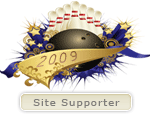Not entirely. Cover materials are rated by the USBC using three test criteria: Coefficient of Friction (COF) in oil, COF on dry lane, and oil absorption rate. The problem is that these numbers are never made public (with the exception of some Ebonite balls that put the oil absorption rate on the ball with no explanation of the meaning of the number). Since the numbers are never made public, we can only go on experience in terms of evaluating the cover materials of different companies. My own experience over the past several years has been mainly with Brunswick and Storm, so I will limit my observations to these two brands. From what I've seen, Brunswick balls find more friction in the oil and react less to the dry parts of the lane. Storm balls, on the other hand skid more in the oil, and react more violently to the dry. My guess is that Brunswick balls have a higher COF in oil, and Storm balls have a higher COF in the dry. Is this making a value judgement? Not at all. I have both Brunswick and Storm balls in my arsenal and use them according to the lane condition and the part of the lane that I decide to play.
Until ball companies decide to share the test results on their cover materials, we have nothing to rely on but our own experience and the experiences of others. To consider that chemical differences do not exist between cover materials from different manufacturers is naive at best.














Bookmarks